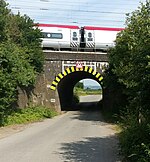Slapton, Buckinghamshire
All pages needing cleanupCivil parishes in BuckinghamshireUse British English from September 2013Villages in BuckinghamshireWikipedia pages needing cleanup from September 2011

Slapton is a village and also a civil parish within Aylesbury Vale district in Buckinghamshire, England. It is located between the Grand Union Canal and the boundary with Bedfordshire, about 3 mi (5 km) south of Leighton Buzzard and 3 mi (5 km) west of Edlesborough.
Excerpt from the Wikipedia article Slapton, Buckinghamshire (License: CC BY-SA 3.0, Authors, Images).Slapton, Buckinghamshire
Horton Road,
Geographical coordinates (GPS) Address Nearby Places Show on map
Geographical coordinates (GPS)
| Latitude | Longitude |
|---|---|
| N 51.8778 ° | E -0.6442 ° |
Address
Horton Road
Horton Road
LU7 9DB , Slapton
England, United Kingdom
Open on Google Maps








